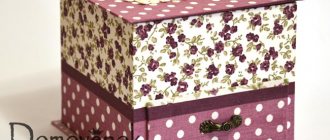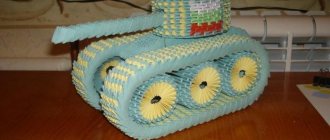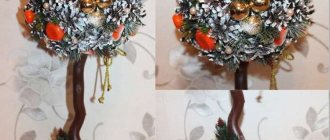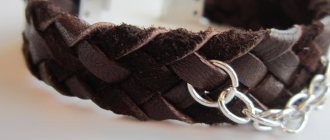Needlework
06/27/2018 Anastasia Prozheva
The art of bonsai came to us from Japan and literally means “a tree grown on a tray.” To grow such a tree at home, you can take a crooked seedling with a good root system from the forest or cottage. You can also make a bonsai with your own hands from artificial materials; you won’t need to bother with such a tree for many years.
It is worth noting that living bonsai can be grown from many trees, even fruit trees; for beginners in this matter, you can try pine. It is better if the tree trunk is as thick as a finger. How to make a bonsai tree from living cuttings and all the principles of its long-term cultivation are known to experienced gardeners. They have to go through many years of experience in forming a real living tree. Just imagine this difficult process that requires constant supervision.
You can try to make a pine bonsai yourself. Find a sprout in the forest with a trunk the size of your finger.
This seedling needs to be dug up in the fall, carefully, without damaging the root system and without shaking off all the soil, and transfer the finished seedling home along with the soil where it grew.
Plant in a pot with drainage. The tree requires many years of care, including the trunk, foliage and root system; once a year, such trees are transplanted into larger containers. Excess good stems are cut off and the branches are artificially directed to obtain the effect of a tree grown under the yoke of the winds. Trees in “captivity” grow slower than in nature, so trees are generally grown no more than 1.5 m in height. The photo below schematically outlines the entire process of preparing for growth in the first year. Water the tree as often as possible and make sure it is well established. You will understand this if the plant produces new shoots.
Related article: How to sew a denim skirt: pattern and job description
At the end of the first year, the tree is removed from the container and planted again, leaving a small upper part of the roots exposed to the air. Excess shoots are cut out and the trunk is slightly incised for artificial aging. And so every year. It is advisable to do replanting in the spring. Add liquid fertilizer based on bird droppings, which is sold in specialized stores.
What types of Crassula are suitable?
To form a beautiful tree in the Japanese style, you need to choose the types of Crassula that correspond to such processing. Types of plants suitable for money tree bonsai:
- Crassula ovata is a bush with good branching. The branches are topped with juicy small oval-shaped leaves.
- Crassula hobbit - has oval-shaped leaves, fused from the base to the very middle. At the same time, they are turned outward.
Crassula bonsai
- Crassula tricolor - differs in the color of the leaves. The plates are painted green with white stripes along them. The leaves have a red edge.
- Silver Crassula - the leaves are covered with silvery dots that create a silvering effect.
- Crassula minor is a small plant with leaves that have a red tint. The length of the plates is about 1.5 cm.
Suitable species
Selecting a design option
Before you start growing or creating an artificial bonsai, it is important to decide what the basic concept will be. There are many photographs on this topic to help beginners. Designers and specialists of Eastern culture do not advise beginners to completely repeat all the nuances and elements of the stylistic concept used by the masters of China and Japan. To understand the basics of the art of bonsai, you need to train diligently for several years and diligently care for a miniature tree. If the bonsai will not be given to a resident of an Asian country, then there is no need to achieve maximum detail.
According to the degree of complexity, miniature trees can be divided into two types:
- decorative. When creating such a bonsai, they do not use a lot of natural materials. Apart from the tree itself, which is a living object, all other elements are produced exclusively from artificial objects and materials. For example, non-natural moss is used to decorate the composition. Any artificial materials are easier to care for, they do not lead to the appearance of a bacterial environment and fungi;
- natural. During their creation, it is important to take into account the main cultural, design and historical traditions of Asian countries. In Japan and China, it is strictly prescribed how all elements should be located. It takes much more time to create such a bonsai.
How to grow a miniature Crassula tree with your own hands
DIY pine bonsai in the garden
Before you make a bonsai from a fat plant, you need to grow it. To do this, you need to choose the right container and plant.
Selection of capacity
You can grow Crassula bonsai only in a special pot. The container is a rectangular bowl or pot. The height of the container is no more than 10 cm. There are 2 holes at the bottom through which excess moisture escapes. Additionally, roots can be fixed in the holes during the rooting process.
Bonsai container
Landing
To plant a fat plant yourself, you just need to choose the right substrate. Prepared soil is usually used. You can make your own soil mixture. To do this, you need to mix turf soil with sand in a ratio of 7:3. A layer of fine expanded clay is poured onto the bottom.
Planting Crassula
Procedure:
- The soil mixture is well moistened with a spray bottle.
- A hole is made in the center into which the root system of the plant is placed.
- Next, you need to sprinkle the hole and compact the soil a little, and spray again.
- For greater stability, stones are installed near the trunk. You can sprinkle the soil with small pebbles or expanded clay.
Artificial bonsai using beading technique
Another tree that will not need to be looked after as carefully as a living one can be made from beads. To create your own beaded bonsai you will need:
- Beads of several shades – approximately 80 g.
- Beaded wire 0.35, 1 and 3 mm.
- Brown threads for winding the trunk and branches.
- Glue.
- Plaster or alabaster.
- Brown paint.
- Decorations for supplying wood - moss, pebbles and more.
beaded bonsai
Master class on beaded bonsai step by step:
- First of all, make the branches. You need to start with the smallest elements of the crown. To do this, cut 45 cm of wire with a diameter of 0.35 mm, collect eight beads on it and form a loop from them. Repeat the same procedure on this piece of wire eight times.
- Twist the two resulting ends of the wire together, thus forming a small bud of loops. Trim the resulting stem to a length of 10 cm. In total, you need to make 150 of these buds.
- Select three small blanks and assemble them into one larger one, as in the photo. The result will be 50 buds.
- From the obtained parts you can already begin to form the branches of the future tree. Twist the three pieces together and wrap them with thread for a few centimeters. This results in the top of the branch and its base. In the same way, connect several more pieces of two or three stems. Attach the resulting bundles to the sides of the base a few millimeters below the top. The first, top branch of the bonsai is ready.
- Make a few more branches in the same way. Take 12 cm of single wire and tie them to the base. In this way, the second level of branches is formed, which has four branches.
- Below, attach two more formed branches with an additional bunch of leaves. This results in five branches. In fact, you can shape the trunk in any way you like and give the branches your own desired shape.
- Once all the branches are ready, you can begin assembling the tree itself. If you have any difficulties with how to make branches correctly, you can watch a video that describes the process of creating a bonsai in a very step-by-step manner. Take the thickest, three-millimeter wire and screw the branches of the first level to it. In the same way, attach the second and third level of branches to the improvised trunk. Wrap the trunk and joints with brown threads. Bend the remaining end of the thick wire downwards.
- An ordinary ceramic bowl or plastic mold is suitable for the role of a stand. Wrap the future stand in a plastic bag, prepare a plaster or alabaster solution and pour it into a plate or mold. Fix the woven tree in the solution and wait for it to harden.
- Mix some alabaster or plaster with glue and coat the trunk and branches of a beaded bonsai with the resulting mixture. When it dries a little, use a toothpick or needle to apply grooves to the main part of the tree, imitating bark. Dry the product completely.
- Holding the bag, remove the frozen plaster base from the mold.
- You can move on to painting the barrel. First, paint it with brown paint, then apply additional bronzer using a stiff brush or sponge.
- All that remains to be done is to decorate the finished bonsai. At this stage of work, the creator is given enormous scope for imagination, which will allow him to turn a tree made with his own hands into a real masterpiece.
It is not at all necessary to use only green beads when weaving your small artificial tree. You can, for example, replace it with yellow, and then you will get an autumn bonsai. You can turn a coniferous artificial tree into a cherry blossom tree or simply add a few blooming flowers.
Trimming
DIY bonsai - growing plants at home
Crassula requires proper pruning to develop a beautiful crown. Additionally, you need to organize a system for the formation of the trunk itself, as well as the branches. When using such a plant, it is important to do everything to make the trunk as thick as possible.
Formation of a thick trunk
This can only be achieved after the plant grows thick branches that originate at the very base. When the required shape and thickness is achieved, the branches are cut off. Over time, the cut begins to tighten, forming a dense top.
Formation of a thick trunk
How to form a crown yourself
Rules by which you can form the crown of a tree without harming the plant itself:
- Pruning should be done during the growing season.
- Think over the future shape of the crown. Mark the branches that will form the crown.
- Form the cut along the main stem.
- It is advisable to leave leaves only at the tips of the branches that are left to create a crown.
Crown trimming
Important! You cannot immediately cut off all excess or unnecessary lateral processes. If you do this, the plant may die.
Regular repeated pruning will improve not only the appearance of the plant, but also its condition.
How to make a bonsai from plastic bottles: a collection of ideas
And in this case, there are many variations on how to use plastic as decoration.
The two most common options:
- Leaves from plastic bottles . Leaves from a green bottle are cut out and melted over a flame, taking the desired shape. Many such leaves form the crown.
- Squares made from plastic bottles. Small squares or rectangles are cut, which subsequently need to be placed on the wire. These pieces are also heat treated. The wire is folded in half to form branches. It's not a quick job, but this way you can imitate a coniferous tree.
How to trim step by step
Money tree diseases - why leaves fall off the money tree
Initially, special tools are prepared, but well-sharpened scissors can also be used. The blade must be treated with a disinfectant. Beginning bonsai growers should follow a clear pruning pattern. Step-by-step algorithm:
- First decide on the shape of the crown.
- Use threads to mark the branches that will remain for further growth.
- Cut off the top to the very bottom. This will slow down the growth of the fat woman.
- Remove the lower branches by cutting them right to the base.
Note ! Sections can be treated with activated carbon powder to prevent infection.
After a few weeks, you can begin further formation of the crown.
Wire wrapping
To make any shape for the trunk of a young fat woman, many use wire. But in this case such a technique is undesirable. The trunk of the plant is quite fragile and can break under the influence of the wire. In Crassula it is better to prepare the desired shape of the trunk by cutting off the lateral processes.
We create an artificial bonsai with our own hands
Beginners will do well to watch thematic videos dedicated to the process of making bonsai. This is necessary to control the correct execution of each stage. For a beginner, it is recommended that all work be divided into several stages. First, a video or photo fragment is viewed, after which the same is done with the materials at hand. It is important to note that you need to take care in advance of having several dry driftwood and dry inflorescences, for example, hydrangea.
It is better to take a slightly larger piece of driftwood than is required for the project. Not everyone is able to realize an idea with their own hands the first time.
In addition, you will need a number of other materials:
- Pot;
- Plasticine;
- Nippers and scissors;
- Acrylic paint and varnish are purchased only in aerosol form;
- Glue "Titan";
- Pink pebbles;
- PVA;
- Gypsum – used to form the base.
As the process of collecting the necessary tools and resources is completed, it is necessary to smoothly move on to the first stage of making bonsai. Of course, it would be naive to expect an impressive result the first time. People who do not feel the necessary strength within themselves always have the opportunity to attend a master class by a famous master.
Topiaries are no less popular than bonsai. You can make them yourself from almost any materials. Read more about this in our material:.
Rules for pinching young Crassula
- Pinching is done with your fingers.
- The desired process is removed with rotational movements. In this case, no fibers from branches should remain on the trunk.
- The pinched area does not need to be processed.
Note ! Pinching should be done regularly so that the young plant develops faster.
Topping
Over time, 2 new shoots will form at the pinching site.
Further care
In order for the plant not to die and to develop normally, it is necessary to create the necessary conditions for this.
Temperature, lighting, location
The pot with the plant should be placed on a well-lit windowsill, but with partial shade from curtains. Home lighting will be sufficient, but in winter, additional lighting may be needed. A flowerpot with a fancy tree can be placed on a table, shelf or cabinet near a large window.
Place for a tree
How to water a money tree
Abundant watering is important for the plant. Water is necessary to nourish the dense leaf plates. It is advisable to adhere to the irrigation regime. The soil needs to be moistened at the slightest hint of drying out.
Fertilizer
Complex fertilizers can be used as fertilizing. During the rest period, it is important to exclude nitrogen-containing products.
On a note! It is necessary to use a minimum dose of fertilizer to prevent the tree from growing uncontrollably.
Replanting bonsai from Crassula
Crassula is replanted once every 3 years. When pruning the roots, you can remove only 1/3 of the total mass.
Procedure:
- Prepare a bonsai pot with a drainage layer. As a soil, you need to use a soil mixture containing peat.
- Moisten the soil well.
- Land.
Powerful tree after planting
Artificial Bonsai Tree: What is it?
Usually work on creating such a tree begins by looking for a good branch for the trunk. Sometimes the branch is a slow-growing plant that, for example, no longer develops. Due to improper growth conditions, the plant acquired an not entirely correct shape - thickening, unevenness, curvature. And these defects can, paradoxically as it sounds, be turned into art.
The base is a container that must be filled with clay, plaster, even plasticine. In a word, something that will hold the mini-tree.
Possible difficulties and common mistakes
Crassula bonsai is an unpretentious type of indoor plant, but some fatal mistakes in the care process can lead to the death of the tree. Helpful Tips:
- During watering, water should not be allowed to fall on the leaves.
- Transplantation should be done once every 3-5 years.
- During transplantation, you need to treat the root system, removing rotten areas.
- When removing shoots, you should not use putty; the ideal option is activated carbon powder.
If you follow these recommendations, then there will be no problems with the growth and development of the money tree bonsai.
DIY artificial bonsai (video)
Bonsai is an unusual representative of the land of the rising sun, which has given people the opportunity to create plant compositions of unusual shape. You can create these at home, both from natural and organic materials. If the first option is suitable for everyday use and is durable, then the second option will appeal to a supporter of the Eastern direction.
Read about which plant to choose for a real bonsai in our article:.











